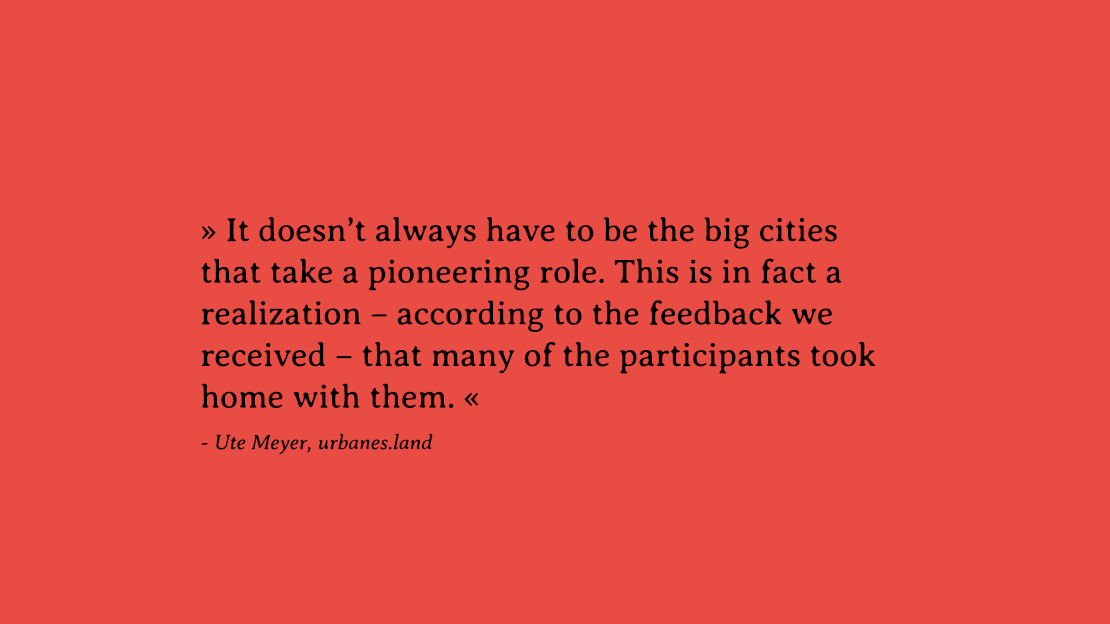Looking from the in- rather than the outside, from the existing and not the expanding – the aim of the Transforming Peripheries Magazine – a joint effort of urbanes.land and topos – is to concentrate existing knowledge about urbanised territories and connect the realms of academics and practitioners across borders, sectors and regions. For one year, the magazine will act as a platform for exchange and connection. It will share best-practice strategies, reflect on what works, and provide levers to influence the spatial development agendas of policy makers, urban planners, business leaders, academics and community groups alike. We encourage and welcome all parties to add, dissent or comment on the magazine. Dynamic exchange, instant reflection and a broad spectrum of different angles are some of the best things an online magazine can offer.
Decentralised territories are underrepresented in urban discourses, although they often include ‘hidden stars’ of regional socio-economic development, high levels of innovation and a full integration in the global economy. However, their fundamental challenge there is to achieve better accessibility. To enable it, the movement function of transport needs to be brought together with the location of opportunities, as our author states.
How do we want to live? This is the question posed by IBA’27, the International Building Exhibition to be held in Stuttgart and the surrounding region – in the German state of Baden-Wuerttemberg. Until 2027, this exhibition will look for answers to how cities, villages and settlements in the highly industrialized metropolitan region of Stuttgart can meet social, technological and ecological change. Above all, the aim is to rethink, perhaps even reinvent, an urban region and to develop a new definition of city and region. Is city the same as region, region the same as city? We talked to the artistic director of IBA’27, Andreas Hofer, about cultural images, accelerators of transformation, the legacy of modernity and why places on the edge, places of transition, of being in-between are precisely spaces of the future.
When it comes to cosmopolitan urbanity all eyes are on the metropolises, the large cities. There are only a few examples that teach us anything about how small communities deal with issues of migration and integration. In order to understand the differences between a metropolis and smaller towns that have little diversity the authors interviewed mayors and administrations in eight small towns in the German federal state of Brandenburg. They state that only a mixed form of top-down and bottom-up activities promises a sustainable transformation of smaller cities.
This article calls for a territorial dimension of the European Green Deal for cities, towns, villages, and regions. Starting from the challenge how to realise the Deal, to target climate change, and how to decide for the next generation of public policies in and after the Covid-19 pandemic, we should face the multiplicity of spaces beyond metropolis.
French-Swedish architect Anna Chavepayre and her family live in the French village of Labastide-Villefranche, situated between Biarritz and Pau. Due to the prevailing centralization of France, Anna sees it as a matter of course to invest in the smaller villages and link them together in a network to foster sustainability.
The architects Kateřina Frejlachová and Tadeáš Říha reflect over the architecture of logistics in the countries of Central and Eastern Europe and over the spatial impact of global supply chains on peripheral territories.
Martin Spalek and Ute Meyer, urbanes.land, on urbanised territories as a structural opportunity for sustainability and reserve of levers for their transformation.
Barbara Lino, urban planning researcher at the Department of Architecture at the University of Palermo, on “reserves of resilience” for sustainable settlement development in Southern Italy.
Christof Mayer, raumlabor and Ute Meyer, urbanes.land, discuss in-between territories and experimental ways to decipher and picture their character from a physical distance.
The photographer Eric Tabuchi and artist Nelli Monnier dedicated ten years of their life to documenting and describing what they define as territories of France. Martin Spalek talked to Eric Tabuchi about the project.
The relationship between urban and rural spaces is changing at a very dynamic pace. studio amore, Berlin-based urban designers, focus on the issue of transformation in rural areas. They have a vision of the countryside that differs from others.
Sören Schöbel and his research team from TU Munich: A plea for the same basic ecological and social objectives to be pursued in cities and in the urban land, following a new urban contract for the European City.
Tom Holbrook, director of 5th Studio Architecture and Urbanism, London, on future planning options for UKs Fast Growth Cities and the challenges to the proposition of sustainable development.
Podcast: The German-American Urbanist Mark Kammerbauer and Suzanne Potjer – the Project Leader of the Urban Futures Studio project “Experimenting with Cities” at the University of Utrecht on the experiment and its governance.
Video Interview: Christoph Hupfer, professor for mobility planning at the Institute for Traffic and Infrastructure in Karlsruhe, in a conversation on the benefits of integrating transport and land-use planning.
No more sense in terms like urban and rural – all land man made. Productive landscapes – urban resorts. Infrastructure blurring any idea of centre and periphery. Housing crouching to motorways, people in constant departure and arrival. Flux and persistence of plants and artefacts. Living between projected networks, unintended ruptures and innumerable gardens – spaces in oblivion? Hidden potentials in plain sight?
Imagine the future is not in the city, but instead in rural areas, where radical changes are taking place. Imagine the countryside could be more futuristic than any big or smart city. This is what Rem Koolhaas, the Dutch architect and urbanist, states in the current exhibition for the Guggenheim Museum. The exhibition addresses urgent environmental, political, and socioeconomic issues through the lens of Koolhaas and Samir Bantal, Director of AMO, the think tank of the Office for Metropolitan Architecture (OMA). Could the answer of all urban challenges maybe lie within the countryside?
No longer rural, not yet urban. Urbanised landscapes display manifold expressions of urban phenomena. Join us in forming a wide-ranging visual collection of people and places characterizing peripheral conditions.

Urban Land Conference revisited
Read more

The transforming peripheries magazine is a project by the research and transfer initiative urbanes.land and topos, the international review of landscape architecture and urban design. The format supports the researchers’ purpose to link public interest in manifold expressions of urban phenomena to new ways of professional reporting.
urbanes.land is a part of InnoSÜD, a university network with the goal to enable a sustainable exchange between science, industry and society with innovative transfer formats. The networks aim in the medium term is to create a dynamic innovation system which positions the Donau-Iller-Riß region as a link between the metropolitan regions of Stuttgart and Munich among Europe’s most competitive and innovative regions. The Federal Ministry of Education and Research (BMBF) and the federal states are funding the project over a period of five years.

















